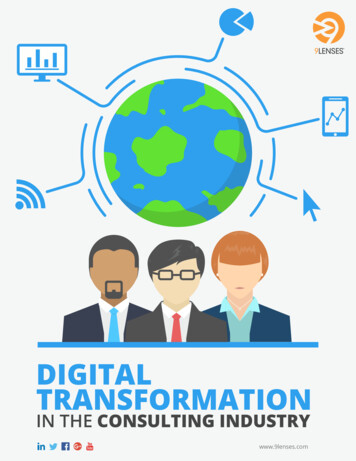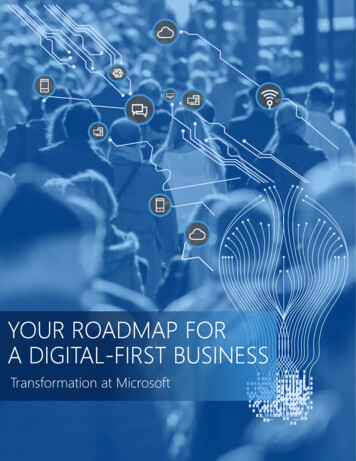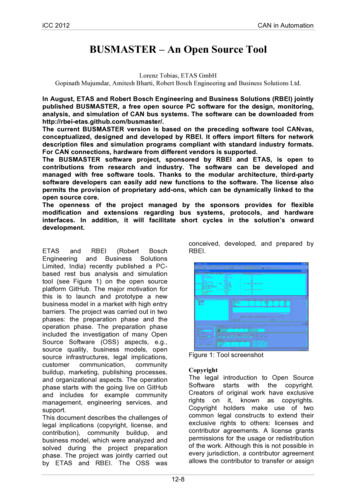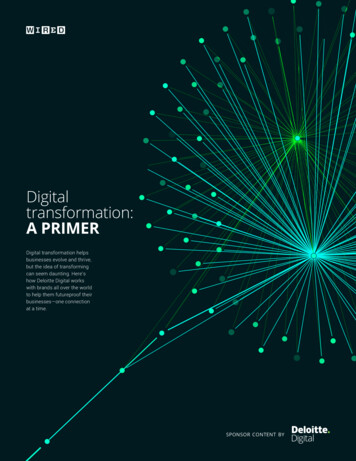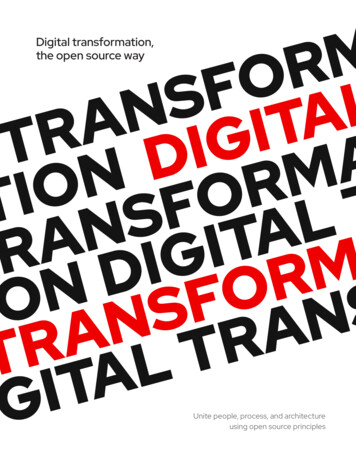
Transcription
Digital transformation,the open source wayUnite people, process, and architectureusing open source principles
Transformyour organizationBuild a better organizationwith open sourceChapter 01Understand the five elements of digital transformationChapter 02Adopt an open approachChapter 03Practice open transformationChapter 04Transform together02
Understand the five elementsof digital transformationPrevent common failures and produceorganizational benefitsDigital transformation is about creatingnew possibilities for your organizationthrough innovative products andservices, better ways of working,and nimble organization models.While organization leaders understandthat digital transformation is criticalto ongoing success, researchdemonstrates that only one in fivedecision makers surveyed rate theirtransformation strategies as effective.1Red Hat helps companies of alltypes with their digital transformationjourneys. Along the way, we’ve identifiedfive areas within an organization thatmust commit to change to affectlong-term success.Weakness in even one of these areascan reduce the value of transformation—or derail the effort entirely.When digital transformation fails,it is often because people andprocesses do not get the sameattention as technology.The five elements of digital transformation641. LeadershipEstablishes the tone.Decentralizes decision making.Creates a shared vision and strategy.Removes barriers to communication.Incorporates transformational goalsinto every employee role.of organization leadersadmit that their digitaltransformation efforts aread hoc and short-termwith disparate areasof innovation.22. Product managementTranslates the vision and strategy intoactionable tactics.Iterates to gather data that validatesmodels or provides lessons from failures.Devises hypotheses they can rapidlytest—versus creating requirements.² IDC InfoBrief, sponsored by RedHat and Intel “An Open Approach toDigital Transformation,” July 2020.¹ Harvard Business Review, sponsored by Red Hat, “Rethinking Digital Transformation:New Data Examines the Culture and Process Change Imperative in 2020,” 2020.03
3. DevelopmentRapidly implements product models using moderndevelopment tools and agile processes.Uses faster feedback cycles for validation oradditional learning.Focuses on delivering the best product capabilities.4. ArchitectureProvides a stable technical foundation suitable forboth short- and long-term objectives.Embraces open, interoperable technologies.Provides more flexible IT deployments.Balances the efficiency of standardization against theneed for customization.5. OperationsEstablishes a foundation of resilience from unreliablecomponents by adopting site reliability engineering(SRE) concepts.Seeks to eliminate toil through automation.Embraces action despite risks.Uses transparent metrics to measure results.When these elements areaddressed holistically:LeadershipCreates a safe environment where employees canexplore new ideas—and fail without retribution.Develops an organization that’s more adaptable,transparent, and collaborative.Product management and developmentWork together to establish a strategy of differentiation.Differentiate the organization's products and services.Architecture and operationsForm a strategy of efficiency.Ensure that resources are optimally used to minimizewaste and costs.04
If transformation is theprogressive accumulation ofhabits, simply understandingthe elements required for asuccessful digital transformationisn’t enough. You also need toadopt an open approach.Learn more about the five elements and how toposition your organization for success.Download the checklist05
Adoptan openapproachTransform your architecture,process, and cultureTransformation doesn’t begin and end with technology.While it’s a significant part of the journey, it’s not the onlyarea that needs attention.By taking an open approach to architecture, process, andculture, you are able to change more than your technology–you transform the way your entire organization operates.Open architecture:A catalyst for changeOpen source software starts with curiosity and the desireto solve a shared problem. Combining the ideas and skillsof a diverse talent pool, community-based, open sourceefforts result in quality solutions that evolve beyondsimple profit motives.Built on passion and shared ideas,open source software shifts thepower of technology from ITproviders to the people using it.06
Open process:Rethink how you workIn the open organization model, collaboration is key.Traditional development practices built on segmentedand monolithic team structures lack the agility requiredto achieve transformation. Modern, open practicesestablish common goals and empower teams tomove forward together.“Teaching an elephant to dance.”Learn how to transform your teams,processes, and applications.Download the executive summaryWith unified IT that’s focused on a singular purpose, yourinfrastructure, application development, and creativeteams can:Rapidly prototype with proven open source libraries.Develop passionate, productive employees.Use automation for continuous integration anddeployment.Open culture: Organizefor innovationOrganizational roles nolonger fit into easycategories such as techand nontech. Digitaldisruption impactseveryone, which meansthat all roles should beincluded in transformativeefforts. Responding totechnological changescan mean rethinkinghow you work.When organizationstake an open approachto culture, they canreact faster and moreeffectively to industrychanges—and encourageinnovation.Open organizations aremore transparent, inclusive,adaptive, collaborative,and community-focused—the same principlesthat power open sourcedevelopment communities.When you view digitaltransformation as acontinuous process—andemphasize the importanceof culture in parallel to,not at the expense of,technology and process—you’re positioning yourorganization for asuccessful transformation.07
Slovenská sporiteľňa, the largest retail bank inSlovakia, took a three-phase approach to opentransformation:³Open cultureThe bank established cross-functional agile teams that included analysts,business users, developers, and engineers.Open processThese teams worked together to optimize deployment processes andmove from quarterly to monthly releases.Open architectureThe bank focused on tools, including on-premise implementationof Red Hat OpenShift and Red Hat Ansible Automation Platform.During this phase, the bank worked with Red Hat Consulting to standardizeand automate application development and deployment processes andengaged with Red Hat Training to provide instruction on best practicesfor Red Hat OpenShift administration.Previously, communication between departmentswas poor. Now, our development and operationsteams work more closely together and focus onvaluable work. The capabilities that OpenShiftprovides in support of this new, more agileculture was a key reason for choosing it.Andrej SimkovicHead of Automation and Technology, Slovenská sporiteľňa³³ Red Hat case study, “Retail bank speeds delivery with Red Hat Ansible andOpenShift,” 2020.08
Practice opentransformationAdopt the right tools and resourcesOpen organizations cultivate peoplewho are innovative, agile, engaged, andaccountable—people prepared to helpyour organization adapt to future wavesof disruption.At Red Hat, we want to make sureyour people have the right tools andresources during transformation, so thatyour organization will benefit from theagility and security provided todayand tomorrow.Red Hat’s vision of openhybrid cloudToday’s technology is built on hybrid architectures, relyingon continuous delivery of microservices to keep up withrapidly shifting customer demands.In this fast-pacedenvironment, the abilityto align IT with businessstrategies requirestechnology solutionsthat can keep pace.Red Hat’s open hybrid cloud is an approach that enablesapplications and data to easily move across ITenvironments. Built on an open source foundation, openhybrid cloud supports:Portability and integration across heterogeneouscloud environments—private or public, physical,or virtual.Red Hat solutions help you bring IT and the organizationtogether with technology that connects teams throughautomation, hybrid cloud infrastructure, containers,application development tools, and more.With open technology, you can do more with the solutionsyou have, while transforming your organization to supportnew and innovative initiatives that can set it apart.Operational excellence through automation andmeasurement.The ability to build and manage a full IT stack thatworks on the infrastructure of your choice.09
Ignite transformation withRed Hat Open Innovation LabsRed Hat Open Innovation Labs is an immersive, residencystyle engagement where we help translate your ideas intoinnovation and transform your team into agile thinkers thatembrace continual change. Open Innovation Labs acceleratesthe delivery of innovative ideas and teaches customers howto build applications the Red Hat way. We do this by:Using community-powered innovation to deliver thelabs experience.Igniting transformational change with a portfolio ofofferings for everyone from individuals to enterpriseorganizations.Establishing a center for experiential learning.Developing open leadership and transformation at scale.Learn how to translate your ideas into innovationwith Red Hat Open Innovation Labs.Download the e-bookCustomer case studyTo improve collaboration and streamlineprocesses to help its technical teamsachieve innovative, valuable results,Meteorcomm engaged with Red HatOpen Innovation Labs.For agile to succeed, you must showpeople what they can do differently toachieve better results and give them theopportunity to practice. Open InnovationLabs encourages true agility. Red Hat’sfacilitators worked side-by-side with ourengineers daily over the course of severalmonths to show them how to be agile.Lance PittSenior Manager, Software Development, Meteorcomm4⁴ Red Hat case study, “Railway technology provider adopts agile workapproach with Red Hat Open Innovation Labs,” 2019.10
Deliver business value quickly with theOpen Practice LibraryAt Red Hat, we develop and reinforce organization agility withthe Open Practice Library. The Open Practice Library is acommunity-driven collection of processes, practices, andtools that help organizations build a culture that canincrease collaboration and accelerate change acrossthe organization, including:Event storming to align software with organization needs.Value slicing to rapidly prioritize work.Usability testing to gather real-world feedback.Retrospectives to reflect, inspect and adapt ways of working.The Open Practice Libraryis organized around the MobiusLoop, an iterative processmodel that generates acontinuous flow of innovation.DiscoveryDeliveryOptionsFoundationThe four parts of the loop are:Discovery, where teams gain an understanding ofproject needs, revisit lessons learned, and see thekey motivations behind what they are building.Delivery, where teams put ideas to the test withiterative processes designed to see which ideaswork and which do not, measure impact, and figureout what comes next.Options, where teams determine what is possible andwhat is needed to achieve desired outcomes.Foundation, where technical engineering practicesmeet collaborative activities to support your journeythrough the Mobius loop, and where Red Hat helpsturn open culture into real business results.11
Discover how Red Hat uses theOpen Practice Library to transform teams.Download the e-bookCustomer case studyVia Varejo, one of Brazil’s largestretailers, wanted to transformits culture, become more digitallyfocused, and modernize itsIT infrastructure.⁵ To adopt aninnovative development approach,Via Varejo engaged with Red HatOpen Innovation Labs to learnabout and apply agile, lean, andDevOps development principles.Activities from the Open PracticeLibrary included creation of a socialcontract, target outcomes,retrospectives, and more.Our immersive residency at Red HatOpen Innovation Labs brought us notonly technical but also cultural benefits.The practices delivered helped ourteam become more collaborative.Open Innovation Labs is undoubtedlya catalyst for agility and efficiency.Marcelo CostaSolution Architect, Via Varejo5⁵ Red Hat case study, “Via Varejo transforms its digital culture with Red HatOpen Innovation Labs,” 2020.12
TransformtogetherWith the same openprinciples applied to allaspects of your organization,everything—and everyone—works together.Start your digital transformation journeywith Red Hat ServicesOpen source is built on the idea that we can accomplishmore together. When cross-functional teams share ideasfreely, innovation accelerates. As a result, teams candeliver more, faster—and with less risk.This collaboration can help your organization eliminatetime- and talent-wasting activities and anticipatetechnology disruption.Red Hat ConsultingOffering more than just technical expertise, Red Hat Consulting uses collaborative servicedelivery, acting as an extension of your team to help you adopt new technologies, transformprocesses, and scale your IT strategy. The Red Hat Consulting team uses approachesdesigned to adapt to your needs, specializing in helping organizations:Modernize their platforms.Embrace modern app development.Implement IT automation.Pursue digital transformation.Red Hat has helped organizations like yours:Achieve hybrid cloud agility withscale-as-you-grow architecturesthat allow for rapid delivery of newcapabilities beyond the limitations ofon-premise hardware and software.Develop a cloud-native approachto iteratively deliver productsthat matter to your organizationand your customers.Automate processes to reducemanual work and free up ITstaff so they can focus on neworganization objectives.13
Having a more stable, scalableplatform and cloud-based architecturewill enable us to give our customersgreater access to innovative financialservices that they never had before.Our teams are inspired to try new thingswith technology. If we had not partneredwith Red Hat Consulting to implementRed Hat OpenShift, it’s very unlikely wewould be where we are today, with teamsin multiple countries working seamlesslytogether on a common platform.Customer case studyWanting to improve the efficiency ofits application processes, Ascend Money,Southeast Asia’s largest financialtechnology company, migrated itslegacy applications to a standardizedcloud-based platform with Kubernetescontainer orchestration technology.⁶During this process, the organizationreceived design and implementationassistance from Red Hat Consulting.Tim HowardFormer Head of Technology Delivery, Ascend Money6Red Hat Training and CertificationRed Hat Training and Certification provides hands-on courses and exams thatbuild and validate the skills needed to maximize your technology investment.From DevOps training to Linux certification, Red Hat offers a practical path tomeet your organizational goals for roles including cloud architect, applicationdeveloper, OpenShift administrator, or Linux administrator.Whether you have adopted new technologies or need to transform skills, RedHat Training and Certification prepares you for on-the-job challenges.⁶ Red Hat case study, “Acend Money builds applications with Red HatOpenShift and Ansible,” 2019.14
Customer case studyEdenor, the largest electricity distributioncompany in Argentina, implementedRed Hat technology to benefit from opensource innovation and meet its cloudcomputing objectives.⁷Edenor worked closely with Red HatConsulting to ensure the new containerprogram and integration technologywere deployed correctly, and engagedin Red Hat Training for hands-oninstruction on the new technology, aswell as agile and DevOps best practices.This transformation was challenging interms of both technical and culturalchanges. We were introducing new conceptslike containers and microservices. Red Hatprovided us with the right tools to overcomethese challenges.María Alejandra TrozziDeputy Manager of Solutions Architecture, Edenor7Experience DevOps culture and applied practicesin a five-day immersive course.Register for training⁷ Red Hat case study, “Argentina’s largest electrical provider streamlinessystem integration,” 2020.15
Red Hat is a leader in opensource with more than 25 yearsof experience collaborating oncommunity projects and developingsoftware that pushes theboundaries of technological ability.Open is in our DNAWe know that open source tools function bestwhen combined with an open culture and processes.When you engage with Red Hat, you’re partneringwith people who understand open technologies,principles, and practices.We help you deliver agile and flexible services,protect your organization assets, and preparefor future change—by uniting teams and openmethodologies—so you can move your organizationforward faster.Find out how Red Hat can help you achievesuccessful transformation.Learn moreStart your transformation to an openorganization model.Request a discovery session16
Copyright 2020 Red Hat, Inc. Red Hat, the Red Hat logo, Ansible, andOpenShift are trademarks or registered trademarks of Red Hat, Inc. or itssubsidiaries in the United States and other countries. Linux is the registeredtrademark of Linus Torvalds in the U.S. and other countries.17
additional learning. 3. Development Provides a stable technical foundation suitable for both short- and long-term objectives. Balances the efficiency of standardization against the need for customization. Embraces open, interoperable technologies. Provides more flexible IT deployments. 4. Arc






